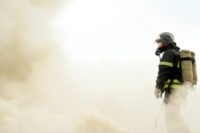 The traditional occupational safety and health programs of the twentieth century were designed, by and large, to prevent work-related injury, illness, and death in workplaces where hazards usually were recognizable and predictable. In the twenty-first century, scientists and decision-makers have had to develop additional skills and strategies to address another type of hazard: the risks that emergency responders face in the line of duty from unpredictable, uncontrolled conditions encountered in large-scale disasters.
The traditional occupational safety and health programs of the twentieth century were designed, by and large, to prevent work-related injury, illness, and death in workplaces where hazards usually were recognizable and predictable. In the twenty-first century, scientists and decision-makers have had to develop additional skills and strategies to address another type of hazard: the risks that emergency responders face in the line of duty from unpredictable, uncontrolled conditions encountered in large-scale disasters.
Lessons learned to date from the September 11, 2001, terrorist attacks, anthrax mail contamination, Hurricane Katrina, the Deepwater Horizon response and cleanup, and other emergencies have informed new strategies for protecting responders. Through the emerging practice of disaster science, researchers seek to continue this progress and to engage increasingly complex challenges.
The National Institute for Occupational Safety and Health (NIOSH) has been a leader in the field of disaster science research. In partnership with other federal and state agencies, as well as with the private sector, NIOSH has made responder safety and health research a high-priority part of its research portfolio.
In January 2014, NIOSH launched the NIOSH Disaster Science Research Initiative (DSRI) to Enhance Responder Safety and Health. This initiative will concentrate on developing an approach to timely, scalable, scientifically sound responder-based research that can feasibly be implemented before, during, and after a large-scale disaster.
Disaster science as it relates to responder safety and health can present unique challenges to occupational safety and health researchers. First, a decision process to determine if a responder research study is warranted needs to be in place in advance of a disaster. Many factors need to be weighed, but it is imperative that a scientific study not interfere with actual response activities. Second, responder safety and health research studies are difficult to design and difficult to implement. Strategic thinking about which study designs and implementation plans are most feasible for responder safety and health studies is important. Third, research can be costly and scientists must assess whether studies are a worthwhile public health investment that will enhance future response efforts. The goal of disaster science research would be to produce useful, reliable results. As emergencies are by definition unpredictable, an accelerated decision-making process is necessary to determine if research should be undertaken.
Some of the potential questions under consideration by the DSRI include:
- Considering the possible types of responses and the responders involved, what are the primary questions needing research? Where are the major gaps in our understanding of exposures and other factors influencing responder health?
- What disaster research is NIOSH uniquely positioned to do?
- What is the role of the academic community in responder safety and health research? What is the role of emergency preparedness and response practitioners and consultants in responder safety and health research?
- What role should biomonitoring play in responder disaster research and how is it best implemented?
- What are the major barriers to disaster science research to enhance responder safety and health?
- How can an emergency responder health monitoring and surveillance system best be used to complement responder disaster research?
- How does disaster research best fit into existing national response policies and systems?
A new NIOSH topic page (http://www.cdc.gov/niosh/disasterscience/) provides further information on the new NIOSH initiative, the resources that inform the initiative, and questions that will help NIOSH and its partners move the initiative forward and better integrate responder safety with other national emergency response strategies.
Please contact CAPT Margaret Kitt at ajy8@cdc.gov or CDR Lisa Delaney at lkd2@cdc.gov if you have any questions about, or are interested in participating in the DSRI.


